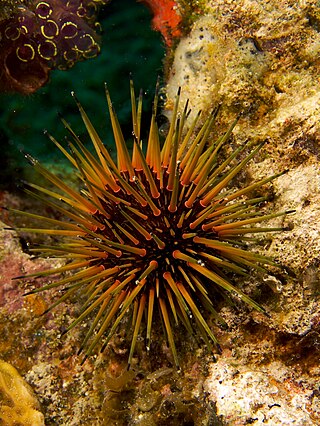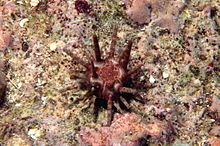
Sea urchins are spiny, globular echinoderms in the class Echinoidea. About 950 species of sea urchin are distributed on the seabeds of every ocean and inhabit every depth zone from the intertidal seashore down to 5,000 meters. The spherical, hard shells (tests) of sea urchins are round and covered in spines. Most urchin spines range in length from 3 to 10 cm, with outliers such as the black sea urchin possessing spines as long as 30 cm (12 in). Sea urchins move slowly, crawling with tube feet, and also propel themselves with their spines. Although algae are the primary diet, sea urchins also eat slow-moving (sessile) animals. Predators that eat sea urchins include a wide variety of fish, starfish, crabs, marine mammals, and humans.

The diadema urchin or blue-black urchin is a species of tropical sea urchin, member of the Diadematidae family.

Diadema setosum is a species of long-spined sea urchin belonging to the family Diadematidae. It is a typical sea urchin, with extremely long, hollow spines that are mildly venomous. D. setosum differs from other Diadema with five, characteristic white dots that can be found on its body. The species can be found throughout the Indo-Pacific region, from Australia and Africa to Japan and the Red Sea. Despite being capable of causing painful stings when stepped upon, the urchin is only slightly venomous and does not pose a serious threat to humans.

Astropyga radiata, the red urchin, fire urchin, false fire urchin or blue-spotted urchin, is a species of sea urchin in the family Diadematidae. It is a large species with long spines and is found in the tropical Indo-Pacific region. It was first described in 1778 by the German naturalist Nathaniel Gottfried Leske.

Loxechinus albus is an echinoderm of the family Parechinidae, native to coastal southern South America, ranging from Ecuador, along the entire coasts of Peru and Chile, to Argentina, as well as the Falkland Islands. It is the only species in the genus Loxechinus. It is known as the Chilean sea urchin or red sea urchin, but the latter name is typically used for the North Pacific Mesocentrotus franciscanus and it is not the only species of sea urchin in Chile. L. albus is found on rocky reefs and shores in the intertidal and subtidal zones to a depth of 340 m (1,120 ft).

Eucidaris tribuloides, the slate pencil urchin, is a species of cidaroid sea urchins that inhabits littoral regions of the Atlantic Ocean. As a member of the basal echinoid order Cidaroida, its morphological, developmental and molecular genetic characteristics make it a phylogenetically interesting species.

The Echinothurioida are an order of sea urchins in the class Echinoidea. Echinothurioids are distinguished from other sea urchins by the combination of a flexible test and hollow spines. The membrane around the mouth contains only simple plates, in contrast to the more complex mouth parts of their close relatives, the Diadematoida. They are nearly all deepsea dwellers.

Dendraster excentricus, also known as the eccentric sand dollar, sea-cake, biscuit-urchin, western sand dollar, or Pacific sand dollar, is a species of sand dollar in the family Dendrasteridae. It is a flattened, burrowing sea urchin found in the north-eastern Pacific Ocean from Alaska to Baja California.

Cidaridae is a family of sea urchins in the order Cidaroida.

Echinometra mathaei, the burrowing urchin, is a species of sea urchin in the family Echinometridae. It occurs in shallow waters in the Indo-Pacific region. The type locality is Mauritius.

Sterechinus neumayeri, the Antarctic sea urchin, is a species of sea urchin in the family Echinidae. It is found living on the seabed in the waters around Antarctica. It has been used as a model organism in the fields of reproductive biology, embryology, ecology, physiology and toxicology.
Aspidodiadema jacobyi is a small sea urchin in the family Aspidodiadematidae. It lives in tropical seas at great depths. Aspidodiadema jacobyi was first scientifically described in 1880 by Alexander Emanuel Agassiz, an American scientist.

Echinometra viridis, the reef urchin, is a species of sea urchin in the family Echinometridae. It is found on reefs in very shallow parts of the western Atlantic Ocean and the Caribbean Sea.

Eucidaris is a genus of cidaroid sea urchins known as slate pencil urchins. They are characterised by a moderately thick test, a usually monocyclic apical disc, perforate and non-crenulate tubercles and nearly straight ambulacra with horizontal pore pairs. The primary spines are few and widely spaced, stout with blunt flat tips and beaded ornamentation and the secondary spines are short and apressed. They originated in the Miocene and extant members of the genus are found in the tropical Indo-Pacific Ocean, East Pacific, Atlantic Ocean and Caribbean Sea.

Eucidaris thouarsii, the slate pencil urchin, is a species of cidaroid sea urchins that inhabits littoral regions of the East Pacific Ocean.

Diadema savignyi is a species of long-spined sea urchin belonging to the family Diadematidae. Common names include long-spined sea urchin, black longspine urchin and the banded diadem. It is native to the east coast of Africa, the Red Sea, the Indian Ocean and western Pacific Ocean. It was first described in 1829 by the French naturalist Jean Victoire Audouin. The specific epithet honours the French zoologist Marie Jules César Savigny who described many new marine species from the Mediterranean Sea and Red Sea. The type locality is Mauritius.

Heliophora orbicularis, also known as the West African Sand Dollar, is a small sand dollar in to the family Rotulidae, and the only species in the genus Heliophora. It, and other members of Rotulidae have been found in West African marine strata from the Late Miocene onward. Like the related Rotula, it is still extant.

Pseudocentrotus depressus, commonly known as the pink sea urchin, is a species of sea urchin, one of only two species in the genus Pseudocentrotus. It was first described in 1864 by the American marine zoologist Alexander Agassiz as Toxocidaris depressus, having been collected during the North Pacific Exploring and Surveying Expedition undertaken by Captain Cadwalader Ringgold and later Captain John Rodgers.

Tetrapygus is a genus of sea urchins in the family Arbaciidae. It is a monotypic genus and the only species is Tetrapygus niger which was first described by the Chilean naturalist Juan Ignacio Molina in 1782. It is found in the southeastern Pacific Ocean on the coasts of South America.

Echinometra oblonga, also called the oblong urchin or 'ina 'ele 'ele in Hawaiian, is a very common rock boring urchin on shallow rocky shores of the tropical Indo-Pacific and Southern Africa.


















